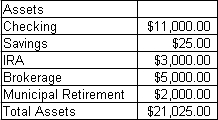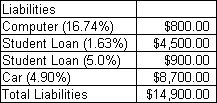Recently, I was asked to help somebody very close to me to get their personal finances in order. They didn’t know what to do with the money building up in a checking account. They didn’t know what to do about retirement saving. They didn’t know what to do about paying off liabilities. I was very happy to help. I enjoy planning personal finances and creating plans. I’ll walk you through how I created the personal finance plan in about twenty minutes. AssetsThe first step is to make a list of your assets. I’m partial to excel, but it’s also possible to do it with quicken online or pen and paper. I listed out all of the assets: checking, savings, brokerages and retirement accounts. The assets list is below.
The checking account is at a major bank with ATMs and branches all over. The savings account is a money market fund earning 0.02%. The IRA account is a traditional IRA that was a 401k rollover. The brokerage account is at the same bank as the checking account and is 80% bonds, which is ridiculous if you’re young (and old in my opinion). The municipal retirement is similar to a pension, where money is pulled out of your account and if you work for a certain number of years you get a pension. Otherwise, you get the money you put in back. The municipal retirement fund is mandatory, which is nice if you reach the number of years, but crappy if you don’t LiabilitiesThe next step is to list your liabilities and the associated interest rate. Below are all of the liabilities:
The computer liability refers to a credit account charging 16.74% interest that a computer was purchased with. The interest on the student loans is on hold as a masters degree is being pursued. Finally, the remaining car liability comes with a 4.90% rate. Immediate StepsAfter listing your assets and liabilities, it’s important to understand your goals. Do you want to maximize your net worth? Do you want to eradicate all debt. Do you want to focus on retirement savings? Do you have more immediate savings goals? Below is how I would first start out shifting funds around. This first part should be done in the first week or two.
As you can see I paid off the computer credit card first. The 16.74% was just ridiculous. Otherwise, I didn’t touch the liabilities. On the assets side, I transferred the savings account funds into the checking account. Earning 0.02% is worthless, you might as well have it in a checking account to have immediate access to it. I also opened a Roth IRA at Vanguard. I took the funds from the taxable brokerage and moved them into the Vanguard Roth IRA for a 2009 contribution. Finally, I opened a high yield checking account that earns 4.15% and moved all of the funds into it except for $1,000. This money is going to act as an emergency fund, an ATM fund and an easy way to deposit checks. The high yield checking account will be set up for direct deposit and most everything will be paid with this account. Future PlansI always recommend determining what your going to do with your excess money at the end of each month. For example, in the above example I set up the following future plans:
List your assets, liabilities and future goals then use that information to develop your plan. Your first stab shouldn’t take more than 20 minutes. The next step of opening accounts, closing accounts and transferring funds takes a week or two. Afterwards it’s a month to month grind to work towards your goals. You’ll be surprised how quickly you can achieve your goals once you’ve developed an appropriate plan. Good Luck. |
How To Create A Personal Finance Plan In Twenty Minutes
Posted in Personal Finances.
– November 20, 2009













Good post I like to do this type of thing as well.
I like to do this type of thing as well.
I still haven’t decided if those high interest checking accounts are worth it.
As long as you make the required number of transactions, there’s no reason not to use a high interest checking account.